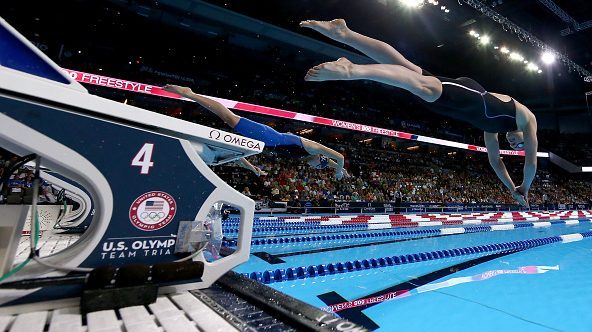Swimming through two waves
April 8, 2021
2020 was a crazy year, to say the least. Everything was on hold, including the 2020 Summer Olympic Trials and Games. With pools worldwide closed due to the COVID-19 pandemic, athletes were hoping for the Olympics to occur like they have every four year since 1896. Athletes around the United States were devastated to hear that the Olympic Trials, as well as the Olympic Games, would be put on pause until 2021. With COVID-19 still rampant around the world, USA Swimming decided to take the week-long trials and break them up into two separate waves.
USA Swimming didn’t see any other choice in order to make the Trials safe and COVID-friendly. The two waves of the Trials are set to happen June 4-7 and June 13-20. In Wave I, all 1,035 qualifiers will compete over the course of four days. However, USA Swimming announced that Wave II will be the sole qualifier for the USA Olympic Team going to Tokyo. All qualifying athletes will get a chance to swim at the meet, but only the top finishers in each event will be able to continue into Wave II. USA Swimming announced that 91.8% of the USA Olympic Team has come from the top 10 seeds of athletes in the past five years, so this is an effective and safe way to host the 2021 Olympic Trials.
Wave I will consist of the lower 550-650 qualifiers for each event. The top two finishers in each event will qualify for Wave II of the Olympic Trials. In the past, the top two qualifiers in each event would qualify for the Olympics, so the organization decided to keep that number consistent. Wave II will consist of about 41 swimmers per event, but USA Swimming predicts closer to 50 athletes will qualify for each event once the top qualifiers in Wave I are added into the mix. The number 41 was chosen because the lowest qualifier in United States history to qualify for an Olympic Trial final event was the 41st seeded swimmer.
This is very different from in the past because instead of having all swimmers competing at the same meet, the athletes will be divided into two waves of competition. In previous years, the Olympic Trial qualifier count has been closer to 1,700 athletes. Due to COVID-19, there have been significantly fewer meets that most swimmers could achieve these times at. However, with fewer athletes competing, Wave II aspiring athletes will have the chance to possibly swim up due to the lack of nearly 700 athletes. This also creates a greater divide between the well-known Olympians and the young teenagers hoping for a chance to prove their skills at the international tier.
USA Swimming also announced that every person that enters the vicinity of competitions will be required to have a negative COVID test; this includes the athletes and spectators. The spectator count at the event will be at 60% of the traditional capacity. This method was proven to be effective because it was tested at the TYR Pro Swim Series, which is one of the Olympic Trials qualifying meets, and it had no reported outbreaks after the event took place.
USA Swimming wants to give all athletes an equal chance to race, and they came to the conclusion that having two waves would be the best option for the meet as well as making the event less crowded. Wave II would also consist of the best of the best, which would make for better races and harder qualifying cuts. The USA Olympic team wants to be as fast and as strong as possible– splitting the trials into two waves in the future would create harder and more challenging races.
Swimming is a very tedious and time sensitive sport; many athletes had to make alternate training plans during quarantine last March. This was very frustrating for many Olympic aspiring athletes because instead of training in the pool, they had to do primarily dryland and at-home workouts to stay in shape. With the United States opening up more, these athletes have been able to get back in the pool and compete again, but the question arises: will these swimmers be as good as they were in the past or has COVID taken a toll on these athletes?
